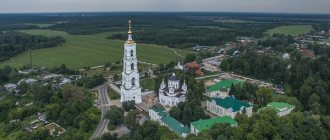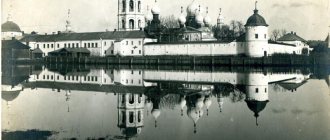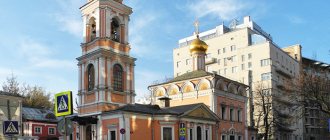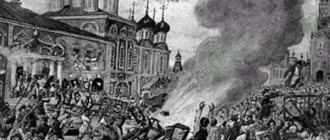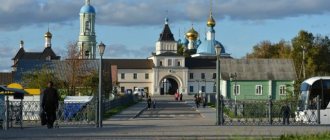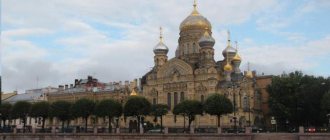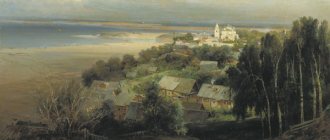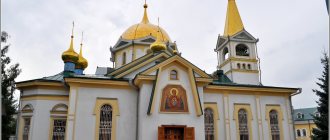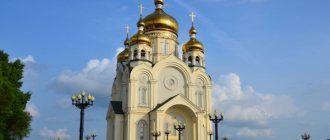The Optina Pustyn monastery is known to many pilgrims. Why is it called that way? The word “Optina” comes from the name of the founder of the monastery, a former robber, who, with the Blessing of God, repented of all his sins and created a monastery (“Pustyn”) for solitary and soul-saving prayers.
However, there is another version of the origin of the monastery. There is an assumption that the founder of the holy place was a certain Vladimir the Brave. In the 14th century, he chose a deserted and no-man's territory among an impenetrable forest to build a monastery for repentant hermit sinners. How to get from Moscow to the monastery and its features will be discussed further.
What is Optina Pustyn famous for?
Optina Pustyn is famous not only for its magnificent churches, cathedrals and bells. The most important pearl of the place is the tombs of the venerable Optina elders, located in the temples of the monastery. This is the soul, the living miraculous treasury of the entire complex as a whole, which attracts and gathers pilgrims and Orthodox believers not only from Russia, but also from all over the world.
Optina Pustyn provides shelter and consolation to orphans, sick people, and pilgrims. It is called the “Orthodox university” of all Orthodox Christians, and primarily because the great elders prospered in the monastery, among whom Father Ambrose enjoyed special spiritual authority.
Pilgrimage - how is it different from tourism?
On the one hand, outwardly and in some of their forms, tourism and pilgrimage may be indistinguishable. In both places, people travel many kilometers from home - by train, car, bus. Some alone, some with a group. Some take a guide, many take photographs as a souvenir... However, the pilgrimage has a different essence, message and goals with which a person goes to the same Optina Pustyn.
Tourism is entertainment. The tourist looks at the world “from top to bottom”. It is not he who is waiting for something and hoping for something, but he “should” be allowed to enjoy, admire, take “everything” from the journey.
Pilgrimage is reverence and the thirst of the soul to come into contact with the shrine. From here, some things on the trip become either less important or even lose their meaning. And other issues, on the contrary, come to the fore. For example, when making a pilgrimage to a monastery, housing is not so important and many are ready to put up with truly Spartan conditions - just to get in return the opportunity to attend real monastic services or have the opportunity to work in a monastery - at least for a few days, at least a little to get away from the bustle of the world and to be closer to the saints and God.
Optina Pustyn is one of the main places of Orthodox pilgrimage in Russia.
Where is
Optina Pustyn is located in the central region of the European part of Russia, on the territory of the Kaluga Orthodox Diocese. However, in essence, it is a stauropegic monastery, since it is directly subordinated to the patriarchate of the Russian Orthodox Church.
Geographically, the monastery is located in the Kaluga region, 72 km from the regional center and 2 km from the city of Kozelsk. The Zhizdra River, a tributary of the Ob, flows next to the cathedral complex.
The road to the place of pilgrimage will give the traveler a lot of unforgettable impressions, since on the way to the monastery magnificent views open up, reflecting the harmonious combination of the shy beauty of the region’s nature with the spiritual principles of Orthodoxy.
XX century
Reviews about Optina Pustyn are the best. People come there to enjoy the beauty of the monastery, pray at the relics of the elders, and visit the graves of the new martyrs. Everyone goes with their own, and there is consolation for everyone there.
Alas, the 20th century left its mark on the history of the monastery. First, the beautiful Optina was turned into a holiday home. According to a local resident, she was still just a child when the monastery was closed. I remembered how the bells were thrown off. And so, the new government decided to build a holiday home in the monastery. Its director gathered local children and gave them gifts. They also gave us scrapers so that the faces of the holy saints of God could be scraped off.
The desecrated monastery presented a terrible sight. The holiday home did not last long. Soon they began to keep agricultural machinery right in the Church of Our Lady of Kazan.
The Church of the Vladimir Mother of God was completely destroyed. The Church of All Saints suffered the same fate. Next to it there was a brotherly cemetery. Dachas were built on it. They say that marble tombstones were used to make floor supports. And somewhere now there are houses whose owners walk on the floor, the basis for which was a tombstone and a cemetery cross...
History of origin
Vvedenskaya Hermitage (otherwise known as a settlement of monks) bears the name of a man about whom little is known. Opta was the leader of a band of robbers who committed robberies in the forests near Kozelsk. For unknown reasons, the inveterate robber repented and became a monk.
Being a monk, when he was tonsured, he was given the name Macarius. Therefore, during the period of its inception (in the middle of the 15th century), the settlement of monastics near Kozelsk began to be called Makarievsky.
The history of the monastery is silent about the life of the founder of the desert, and the place of his burial is also unknown. However, the monastery complex still bears his name.
According to another version, the fact of the founding of the desert belongs to Vladimir the Brave. In the 14th century, prayer hermits appeared in this place. It is assumed that the prince decided to make a secluded prayer monastery here - away from human settlements, in an impenetrable forest, on land unsuitable for agriculture.
From that time on, the place of prayer and the monastery itself were subjected to either spiritual flourishing or shameful oblivion. The difficult years “without time and without God” affected the life of the monastery. However, people have always been drawn here, as to a lighthouse and a soul-saving haven. Well-known writers, politicians, and clergy of their era visited here.
The history of the birth of Optina Pustyn:
| Period | Events, facts |
| 1146 | The first mention in the chronicle of the city of Kozelsk. |
| Since 1213 -… | The territory of ancient Kozelsk and Optina Pustyn was inhabited by Vyatichi people who professed the teachings of St. Kukshi. |
| Since 1238 -… | Kozelsk was taken by the Tatars. In the 14th century it came under the control of Lithuania. Then the city passed several times under the control of different leaders, but ultimately remained under the rule of Moscow. |
| 1625-1689 | A group of prayer hermits settles near the city of Kozelsk and establishes a settlement. In 1625, Abbot Sergius became the head of the settlement (monastery). A few years later, the first church and several cell rooms were built, and in 1689, boyars from local residents erected a cathedral. |
| 1704-1727 | The mill was taken away from the monastery. In 1724, by decree of the Holy Synod, the monastery was abolished. At the request of boyar A. Shepelev in 1726-1727. the monastery was restored, the monastery and its mill were returned. |
| Since 1795 -… | From that time on, the monastery began its active development. By appointment of Metropolitan Platon, new leadership came to the monastery - Filaret (Bishop of Kaluga), Hieromonk Joseph. With their arrival, the monastery began to actively rebuild. |
| 1796-1829 | Fr. was appointed to serve at the monastery. Abraham (hieromonk), who became the founder, architect and builder in one person. Metropolitan Platon really liked the innovations taking place in the monastery, and by his decree the monastery began to receive 300 rubles. for further construction annually. The Synodal Assembly appointed 23 more people to serve in the Optina Monastery. Thus, the eldership was born in the Kozelsky monastery. |
| 1830-1861 | This period of time was the full flowering of the holy monastery. The total number of spiritual brethren was already 150 people, and 20 of them were of high clergy. Since 1840, the confessors of Optina Pustyn began to publish soul-helping Orthodox literature, translate and publish books of great people and spiritual mentors. |
| 1862-1891 | During these years, Hieroschemamonk Ambrose (in Orthodoxy - Ambrose of Optina) was in charge of the monastery; among the common people he was simply called Father Abrosim. He was a man with a big soul and understanding of human nature. Sick, crippled, disillusioned people with life came to him, and the elder found a special approach for each, which earned him sincere love and respect. During these years, Fr. Ambrose founded the Kazan convent in Shamordino, where he lived for more than a year, instructing nuns and sisters in spiritual teaching and self-development. |
| 1892-2000 | The period of formation of Soviet power and the weakening of spiritual principles had a tragic impact on the life of Optina Pustyn. In 1923, the monastery was closed by the Bolsheviks. Part of the monastery premises was given over to a sawmill, and the guest rooms were used as a rest home. But in 1987, Optina Pustyn was reborn. All premises were returned to the monastery, and on June 3, 1988, a prayer service was held for the first time after disgrace. In 1996, the priests of the monastery were canonized, and in 2000, the monastery was designated by the Council of Bishops as a particularly revered shrine of the Russian Orthodox Church. |
History of the monastery
There are three versions of the origin of this abode of God. According to the first, in the 14th century, the fierce and formidable robber Opta lived in the Kaluga forests. He was the leader of the robber "brotherhood". He attacked merchant convoys, robbed them, and brutally killed people.
History is silent about what happened to the mighty Opta, why he suddenly reconsidered his life. He looked at her from the other side and was horrified. He immediately left the band of robbers. The path of the repentant sinner to God began. Opta took monastic vows with the name Macarius and became the founder of the Optina Hermitage in the impenetrable forests near Kozelsk.
According to the second version, everything is much simpler. The date of foundation of the monastery is unknown. Why is it called Optina? Because it used to be mixed, that is, for both monks and nuns. And such ascetics were called Optinas.
And the third version tells that the monastery was founded by unknown ascetics. They went away from human eyes, into impenetrable forests. The forests near Kozelsk, across the Zhizdra River, are the very place where you can hide from prying eyes. The land here is unsuitable for arable farming, which means no one will encroach on it.
One way or another, Saint Optina Pustyn is one of the oldest monasteries in modern Russia.
Optina Pustyn today
In the Optina Pustyn monastery there is a large complex of buildings for both service and economic purposes. Getting to this place from Moscow is simple and doesn’t take long. In the monastery, for a believer, everything is thought out to the smallest detail, because it is not in vain that so many generations of monks worked on this.
Leonid Mozhaisky in front of the clergy of the Optina Pustyn Monastery
Now the Optina Monastery is under the authority of Bishop Leonid of Mozhaisk, vicar of the Patriarch of Moscow. There is an active spiritual life in the monastery; every day it receives a huge number of pilgrims and guests from all over Russia. In all churches and cathedrals of the Desert, prayer services and liturgies are held, according to the internal Optina and Orthodox calendars.
All church sacraments are performed here:
- Confession.
- Participle.
- Blessing of Unction.
- Baptism.
- Consecration.
- Unction.
- Funeral service.
- Memorial service.
In addition, every evening after a meal in the monastery, a procession of the cross is held around the entire territory of the monastery, and on Saturdays a divine litany for the murdered monks is read at the necropolis of the monastery.
1625-1796
According to reviews, Optina Pustyn is the place where the soul, exhausted by the bustle, gratefully rests. And this has been the case since the establishment of the monastery.
What do we know about her first “steps”? It is known that in 1630, instead of a luxurious monastery, there was only a wooden church. The picture was completed by several cells. And the brethren numbered only 12 people. Not a lot, compared to subsequent years.
And yet the monastery existed. Under the direction of Hieromonk Theodore, the brethren carried out their obedience. The then Tsar, Mikhail Fedorovich, allocated land for vegetable gardens to the monastery and donated a mill. And in 1689, the Vvedensky Cathedral was built on the territory of the monastery. Life in the monastery was slowly getting better.
Alas, in 1704 the mill was taken away and the Zhizdra River was forbidden to be used for fishing. It became very difficult for the inhabitants, but with God’s help they continued their lives. The monastery became poor, its economy fell into decay. Moreover, Peter I tried his best and issued a decree according to which the monastery had to pay rent to the state treasury. Naturally, this “tribute” to his own king was beyond the strength of the impoverished monastery. But Peter doesn’t care: he needs money for the war with the Swedes, so he collected it from everyone.
In 1724, poverty was such that Optina Pustyn was abolished. And now she went to the Belevsky Spaso-Preobrazhensky Monastery. Why did they do this? Firstly, due to the fact that there were very few inhabitants in Optina. Only 12 people. The monastery was considered “little-brotherly.” And secondly, there was an unaffordable rent.
True, this unification with the Belevsky Monastery lasted for two years. In 1726 the monastery was restored as an independent one. By decree of Catherine I, by the way. But during these two years, the wooden buildings of the monastery fell apart and fell into complete disrepair.
A year later, in 1727, Optina Hermitage was given back its mill - a gift from Tsar Mikhail Fedorovich - and access to fishing.
The monastery slowly rose. So, in 1741 they began to build a bell tower. And in 1750 - the Church of the Entry of the Blessed Virgin Mary. Construction lasted almost 10 years.
But again reforms. This time Catherine II wanted to intervene in the life of the monastery. The empress did not think for long. With her light hand, namely thanks to the reform, Optina Pustyn became a secondary monastery of the Krutitsa diocese. This happened in 1764.
9 years have passed. The monastery managed to rebuild the cathedral church. Generous benefactors helped. But inside the monastery everything was very sad. In 1773, only 2 monks remained in it. And those are old people.
It is not known how the matter would have ended, but in 1795 Metropolitan Platon of Kaluga and Moscow visited the monastery. He liked the wondrous place so much that the Metropolitan ordered to send a very experienced monk to the monastery. Hieromonk Abraham became its rector.
Temples of Optina Pustyn
Several temples were built in Optina Pustyn throughout the history of its existence. Now there are 8 churches in the monastery, in which divine services take place every day. On great holidays, when there are large crowds of pilgrims, services are held in 2-3 churches at a time.
Operating temples:
1. "Vvedensky". Has 3 thrones. Location of the relics of St. Ambrose, Art. Nectaria. Every day in the church there is a midnight service, liturgy, prayer service for St. Ambrose.
2. "Kazansky". Three-throne. Location of the relics of St. Isaac, st. Moses, Art. Antonia. On holidays and weekdays, an all-night vigil and liturgy are held.
3. "Vladimirsky". Single-Altar Church, custodian of the relics of the elders:
- Barsanuphia;
- Macaria;
- Leo;
- Joseph;
- Anatoly (Zertsalova);
- Anatoly (Potapova);
- Hilarion.
Every day there is a confession and a prayer service for the departed elders.
4. "Preobrazhensky". Has one throne and keeps the relics of St. Raphael. A prayer service and blessing of water are held here daily.
5. “John the Baptist”. Single-throne, located in the monastery. The service is held according to a special charter.
6. Temple of Hilarion the Great. The single-altar church was built behind the wall of the monastery. Baptisms, weddings and funeral services take place here.
7. Temple "Bread Spreader" The single-altar church is located on the territory of outbuildings. Here the “Indestructible Psalter” is read throughout the year without interruption.
8. Mobile temple ik. "Life-giving spring"
A prayer service is held in the single-altar sanctuary on the site of the monastery's garden plots.
Where to stay
There are hotels on the territory of the monastery. They are inexpensive and, as expected, ascetic, with a shared shower. Men and women live separately, and rooms are booked in advance only for organized groups. You can have a snack in the teahouse (the menu mainly includes baked goods), but tourists are usually not allowed into the refectory; only local residents dine there. When staying overnight in Optina Pustyn, keep in mind that you will have to follow all local rules of residence: get up at dawn, dine in silence and pray before and after meals.
Optina monastery
St. John the Baptist monastery is located at a distance from the monastery, behind a small grove. When it was built, they decided to preserve the trees and a small forest so that the monastery would be hidden from view. On weekdays, the monastery is closed to lay people; entry is allowed only on memorable dates and holidays.
The Church of St. John the Baptist is built of wood; it “remembers” the times of the birth of eldership in the Optina Monastery. During patronal feasts, you can pray here and take part in prayer services and liturgy.
Story
According to legend, the monastery has existed since the 15th century. The hermitage provided 2 different monasteries for monks and nuns; it was forbidden to live together. The first chronicle in which the monastery is mentioned dates back to 1629.
During the period of unrest, the monastery buildings were subjected to raids and destruction and did not have time to fully recover from them even by the 18th century. The situation worsened even more when the monastery was forced to pay rent. By 1724, there were only 12 people in the desert; it was decided to abolish it, but 2 years later Catherine I ordered its restoration.
In the middle of the century, the monastery actively developed, a bell tower and a new temple in the name of the Entry of the Blessed Virgin Mary with 2 chapels were built. Optina Pustyn was noticed by the Moscow Metropolitan, and it was decided to annex it to the Kaluga diocese.
By 1821, the monastery acquired a hospital, 2 new churches and a new bell tower. The staff increased greatly, hermits began to settle. Pilgrimages became more frequent and the volume of donations increased.
© Julia
With the arrival of the communists, Optina Pustyn was closed. In 1923 it was listed as a museum, in 1931 it was a holiday home. During the war, there was a hospital here, and towards its end - a filtration camp for checking those returning from captivity.
In 1987, Optina Pustyn again became an Orthodox site and the buildings began to be gradually returned. Today, almost everything has returned to its original appearance and purpose, and restorations have been carried out.
Holy springs
Near the Optina Monastery there are several consecrated springs and a well. All of them are not far from the monastery; monks and pilgrims walk to get holy water.
Holy springs of the monastery:
1. Source of St. Paphnutia.
It is consecrated in the name of St. Pafnutia (Borovsky). The saint's memorial day is celebrated with a religious procession, at the end of which a prayer service is performed with the blessing of water.
2. Source of Seraphim of Sarov.
The source is located in the monastery. Monks visit this place with special inspiration and great trepidation. The source has a small fence and a cross with an icon of Father Seraphim.
3. Amvrosievsky well.
Ambrose Optinsky indicated the location for the well. Now this is a special place for monks and pilgrims.
4. Source of St. Paraskeva.
The source is located in a quiet place in the forest. It was consecrated in the name of the Great Martyr. Paraskeva Pyatnitsa and is the property of the Optina Monastery.
Murder
It was committed by a certain Nikolai Averin. It is known that bell ringers were pierced with a sword. They hit me in the back with such force that my internal organs were cut. This happened at 6 o'clock in the morning.
Hieromonk Vasily was also killed by a blow to the back. He did not die immediately. He lived for about another hour.
According to the pilgrims who stood at the bus stop and waited for the first bus to Kozelsk, at the hour of the murder a strange red glow appeared in the sky above Optina. It was as if blood was spurting out. But then they didn’t even think about blood, they were simply surprised at the unusual phenomenon.
The killer was arrested a week later. He took his punishment.
Relics of Ambrose of Optina
The relics of St. Ambrose of Optina were found in 1998 with the blessing of the Patriarchate of the Russian Orthodox Church. Having received the blessing, the brethren of the holy monastery opened the grave of the elder buried in the monastery necropolis. Particles of the elder’s relics were placed in a reliquary, which was installed in the Vvedensky Cathedral (left side chapel) of the Optina Hermitage.
Since then, the flow of pilgrims to the shrine with the relics of the holy elder has not dried up. During his life, Ambrose of Optina helped everyone who came to him with requests and for prayerful help.
He was distinguished by his special virtue and love for all parishioners, and was a shining example of selfless and selfless service to people. But even now he does not leave his spiritual children. Anyone who, in a high spiritual impulse, turns to him with sincere prayers receives what he asks for.
It's time to go to Optina!
Optina Pustyn
I once wrote and can repeat it ten years later:
“My dear Optina! My friends, my dear friends! Do you want to feel this tenderness, this strange softening of the heart? This yielding to blissful tears? Is this a feeling of childish delight? Love for everyone and everything around you? Forget about fancy sea beaches and expensive resorts! To Optina, quickly to Optina! What you experience here you will never forget, and these feelings will make you come back again and again.
What is this, why is this? My dears, this is the grace of God, which touches our hardened heart and evokes this love and tenderness with which my story is so full.”
What can I add? Summer has passed the halfway point, and if you have not yet made a pilgrimage to Optina Pustyn, the time has come to do it!
Optina Pustyn
***
How to get there
Let's start with the road.
First option
You can get from Moscow to Optina by bus, which goes from the Teply Stan bus station. The bus station is located 50 meters from the Teply Stan metro station (Kaluzhsko-Rizhskaya line, orange line). The bus takes about five hours, a little more or less, depending on traffic jams; makes two long stops lasting 20 minutes each - in Obninsk and Kaluga, you can get out and stretch your legs, buy something edible, and visit public places.
Bus schedule to Optina Pustyn and back.
Ticket price: 650 rubles.
From the bus station in Kozelsk to the monastery there is a minibus “Bus Station - Optina Pustyn” once an hour: 7:30, 8:10, 9:10, 10:10, 11:10, 12:10, 13:10, 14:10 , 15:10, 16:10, 17:10. Travel time: 10–15 minutes, fare: 20 rubles. Sometimes the first and last flights - at 7:30 and 17:10 - are cancelled. This minibus does not operate on Mondays.
You can take the Kozelsk - Sosensky minibus, which runs more often, at intervals of 10–15 minutes, and get off at the stop before the turn to Optina, having warned the minibus driver in advance. From the turn to the monastery there are two kilometers, and if your luggage is not heavy, you can walk.
You can call an inexpensive taxi "Rush", taxi phone number: +7-48-442-3-000-3. The fare is about 100 rubles. If you are traveling with three or four people, it will cost the price of a minibus ticket.
Second option
If you don’t want to take the bus, you can take the train from Moscow’s Kievsky Station to Kaluga.
Train schedule.
Travel time is about 3.5 hours, fare is 450 rubles. You can take the express, then the travel time will be reduced by an hour, but the cost will increase to 530 rubles.
There are buses from Kaluga to Kozelsk. Schedule . Travel time is about two hours, cost is 188 rubles.
So in terms of cost and travel time, both options are approximately equivalent.
***
Where to stay and eat
You have arrived in Optina. It's time to take care of a place to stay for the night.
Near the walls of the monastery there are hotels for pilgrims: eight-bed rooms, a bathroom on the floor. The cost of accommodation is 300 rubles per day. A passport is required upon check-in.
Hotel reservations are made only for organized pilgrim groups by calling (48442) 50-166, but none of the pilgrims stay on the street; pilgrim service workers always take care of their accommodation.
You can eat in the pilgrimage refectory (to the right of the Holy Gates of the monastery), asking for food coupons at the hotel, or in the teahouse, where there is a lot of varied and tasty monastery food: cabbage soup, dumplings with fish (60 rubles), dumplings with potatoes, cabbage (50 rubles), chebureks and belyashi with fish (50 rubles), various pies (with potatoes, lentils, jam, cabbage, etc. - 20 rubles), khachapuri, pancakes with fish and cottage cheese, monastery bread, pizza with seafood, monastery pickles and dairy products from the monastery's subsidiary farm, a variety of salads, Optina honey and other goodies, tea, coffee, juices.
There are five-room guest houses near the monastery; they are more comfortable, but also more expensive. Here you will find a shower, a dining room, lunch and dinner from the monastery pilgrimage refectory.
Accommodation cost:
- single room – 1000 rub./night;
- double or triple room – 800 rub./night per person;
- four-bed room – 600 rub./night per person.
Details about living in Optina.
Forerunner Skete
Male pilgrims who come for a long period of time to work at monastic obediences, after an interview, can settle in the Baptist Skete.
Rules for settling and living in the pilgrimage hotel of the monastery.
There are two bookstores in the monastery, where they sell spiritual books, icons, rosaries, and a shop where they sell church utensils, vestments, etc.
***
Divine services
The canopy and under it granite crayfish with St. with the relics of the St. Optina Elders. Leo, etc. Macaria (foreground)
During the day, the main churches of the monastery - Vvedensky, Kazansky, Vladimirsky and Preobrazhensky - are always open
During the day, the main churches of the monastery - Vvedensky, Kazansky, Vladimirsky and Preobrazhensky - are always open. Everyone is blessed with free entry and access to the holy relics of the venerable elders of Optina.
Details about the temples.
Every day two Liturgies are served in Optina: an early one at 7:00 (Clock at 6:40) and a late one at 10:00 (Clock at 9:40).
On weekends and holidays, three Liturgies are served: the early Liturgy begins at 6:30 (Clock at 6:00), the middle one at 8:00 (Clock at 7:40), the late Liturgy at 10:00 (Clock at 9:40) .
In addition, prayer services with akathists are served every day:
- St. Ambrose of Optina - in the Vvedensky Church at 13:00;
- The Synaxis of the Reverend Elders of Optina - in the Vladimir Church at 15:00.
Evening service begins at 17:00 (9th hour at 16:45).
Kazan Temple. Here are the relics of the elders
Confession takes place daily from 6:00 in the Vladimir and Kazan churches.
Detailed schedule of services.
In the Church of the Transfiguration there are water-blessing prayers and you can always get holy water.
You can swim in the spring of St. Paphnutius of Borovsky at any time. Go from the barrier to the right (there is a sign).
Detailed plan of the monastery and monastery.
Candles in churches - from 10 rubles, custom notes about health and repose - 10-12 names - 10 rubles. Prosphora is available in churches and in a kiosk under the bell tower; a donation for a prosphora is 5 rubles.
The official website of Optina Pustyn with a wonderful design, easy navigation and even a 3-D excursion.
***
What else to see in Kozelsk
Local Lore Museum of Kozelsk
There is an interesting local history museum in Kozelsk; it was founded in 1957 and is one of the oldest museums in the region. Exhibits symbolizing the heroic seven-week defense of Kozelsk in 1238 are stored here, there is a diorama “Defense of Kozelsk from the Mongol-Tatars.” There are also exhibitions dedicated to the nature of the Kozelsky region, its archaeology, ethnography and the Optina Hermitage.
Museum address: Bolshaya Sovetskaya street, 75.
By minibus we reach the intersection, turn right and walk 200 meters. The museum is open daily from 10:00 to 17:00, Monday is a day off, the last Friday of each month is a sanitary day.
Phone: 8(484-42) 2-24-65.
about the museum.
***
Also in Kozelsk there is a forest museum “Forest Origins”, opened in 2001 (mechanical plant area). The museum consists of three halls: historical, nature and fauna, and also dedicated to Russian wooden architecture. There is an extensive video library with films about the life of animals, birds, insects, nature reserves and ecology. The museum also widely presents the history of the development of forestry in the Kaluga region (detailed information).
House of Nature: Bolshaya Sovetskaya street, 71.
***
There are beautiful ancient churches in Kozelsk: the Annunciation Church (1810), the Assumption Cathedral (1824), the Church of St. Nicholas the Wonderworker (1740), the Church of the Descent of the Holy Spirit (1789).
***
In the city Park of Culture there is an observation deck from which an amazing view of the Zhizdra River and Optina Pustyn opens.
About the sights of Kozelsk.
***
Monastery in Shamordino and the monastery of the Savior Not Made by Hands of the Hermitage
Kazan Ambrosievskaya stauropegial female hermitage
Not far from Optina there is the Kazan Ambrosievskaya stauropegial women's hermitage, founded by the Monk Ambrose of Optina near the village of Shamordino in 1884. The entire monastic charter and the sisters’ routine were established by the elder himself.
Under the spiritual leadership of the Optina elders, the monastery became one of the largest monasteries in the Russian Empire, remaining so until its closure and ruin in 1923. Until 1990, the premises of the monastery were used as educational buildings for an agricultural technical school.
Monastic life has been resumed since 1990, the wonderful cathedral in honor of the Kazan Icon of the Mother of God, architect S.V., has been restored. Sherwood.
Currently, more than 120 nuns are working in the monastery under the leadership of Abbess Sergius (Shcherbakova).
The temples of the monastery are decorated with wonderful icons, embroidered with gold, beads, and decorated with semiprecious stones - handmade by the sisters of the monastery. There are wonderful holy springs here.
Monastery website: https://www.shamordino-m.ru/.
Information for pilgrims: https://www.shamordino-m.ru/palomnikam/info/.
You can get to the monastery by bus "Kozelsk - Kaluga". Go to the “Kamenka” stop, then walk two kilometers or, if you’re lucky, hitch a ride. You can take a taxi, the cost from Optina is approximately 400 rubles.
***
Monastery of the Savior of the Hermitage Not Made by Hands in the village of Klykovo
Not far from Optina there is a monastery of the Savior of the Hermitage Not Made by Hands: https://www.klikovo.ru/.
Pilgrims are especially attracted here by the grave and cell of the famous elder schema-nun Zipporah. You can read about the oxbow.
***
It's time to go to Optina Pustyn!
Guardian Angel on the road! Through the prayers of our holy fathers, the elders of Optina, Lord Jesus Christ our God, have mercy on us!
Optina Pustyn is one of the main monasteries in Russia. What is the best way to organize a pilgrimage trip to this monastery? Everyone chooses according to their capabilities and situation. Someone comes for a few hours on a tour to “get to know each other.” Someone stays overnight - and then a unique opportunity arises in Optina to go to confession and maybe receive communion. And someone comes here for a few days and then, perhaps, the Spirit of Optina will reveal itself to the person more fully and he will even remain in it forever - first, as a simple worker, then as a novice, then as a monk...
We came to Optina Pustyn for several days, like ordinary pilgrims, without a group. And we want to talk about the main organizational and other issues that you may encounter if you are going to this monastery for the first time - without knowing anything about its structure.
So, the most important thing you need to know when going to Optina.
Schedule of services
You can find out how to get from Moscow to the Optina Pustyn monastery by looking at the monastery location map. And you can get acquainted with the schedule of all services on the official website of the monastery itself, which is regularly and periodically updated.
Services schedule:
- 30:00 – midnight service (Vvedensky Cathedral).
- 00 o'clock – Liturgy of wounds. (Vvedensky Cathedral, Kazan Church).
- 00 o’clock – liturgy late. (Vvedensky Cathedral, Kazan Church).
- 00 a.m., 13.00 p.m. – prayer reading with akathist Art. Ambrose of Optina (Vvedensky Cathedral).
- 00 o’clock – prayer reading and Cathedral Akathist of the Optina Elders (Vladimir Church).
- 00 o’clock – evening service.
19th century
This is the heyday of the monastery. The beginning of the century was marked by the construction of a new bell tower, the Kazan Monastery, and a hospital church. The population of the monastery has already expanded to 30 people. Abraham turned out to be a wonderful leader. He established an internal routine and strictly monitored the external flourishing of Optina Pustyn. He was a governor, a builder, and an architect.
At the same time, a monastery was built at the monastery. Those who wanted a silent life settled here. People from all sides flocked to the monastery. The monastery lived not only on donations from benefactors. Emperor Pavel Petrovich drew attention to this monastery near Kaluga. Optina was donated a flour mill and allocated 300 rubles annually.
In the 19th century, eldership began to flourish in the monastery.
How to get to Optina Pustyn from Moscow
You can get to Optina Pustyn by any transport or even on foot. It is located 270 km from Moscow and the entire journey, depending on the type of transport, can take no more than 4 hours.
By car
The easiest way to get to the Optina Monastery is by car. You need to leave the capital along the Kievskoye Highway and follow to Kaluga. Before the city you should turn right, towards the bridge over the Oka River. Following the road signs, you need to get to Kozelsk, turn left there and follow the sign “Optina Pustyn”.
By train
Local residents can tell you how to get from Moscow to the Optina Pustyn monastery by train.
First, you need to get to Kaluga by express or regular train from the Kievsky railway station. Next, from the Kaluga bus station, get to Kozelsk, and then to Optina Pustyn - by taxi or on foot.
By bus
You can get to Kaluga by bus from the Yugo-Zapadnaya metro station. An intercity bus to Kozelsk leaves almost every hour (9 trips in total). From the city of Kozelsk to Optina Pustyn you can take a taxi or walk.
“Pitfalls” of traveling by train
The monastery is located next to Kozelsk. But keep in mind that there is no railway in this city. Therefore, plan your route in advance like this:
- From Kievsky station you need to get to Kaluga. The route duration is 3.5 hours. Ticket price – 600 rubles.
- From Kaluga go to Sukhinichi. The route duration is 1.5 hours. The fare is 380 rubles.
- In Sukhinichi, wait for the minibus to the monastery. If energy and time allow, then walk. Distance – 3 km.
Accommodation and meals
The monastery has a hotel for pilgrims. It is possible to rent inexpensive housing from local residents living near the monastery.
The following settlements are offered for pilgrims:
1. Guest houses for pilgrims (shared).
Guest houses with rooms for 8 people, a tea room and a shared toilet on the floor. Pilgrims of the general settlement provide their own food.
Accommodation – 300 rub./night/person.
2. Guest 5-room houses.
Guest houses with shower, dining room.
Accommodation (with meals):
- 1-seater room – 1000 rub./night;
- 2-3-seater room – 800 rub./night/person;
- 4-seater room – 600 rub./night/person.
3. Cells of the Baptist Skete (for men only).
Settlement in the monastery is possible only for men after an interview with the abbot, for a long stay in the monastery, for labor in obediences.
4. Hotel for clergy.
There is a hotel for priests and monks on the southeast side of the monastery, and a certified ID from the diocese is required to participate in services.
There are no shops or eateries on the monastery territory and the nearest village, so it is recommended for guests to take packed lunches with them, and there is always hot tea and pastries in the refectory monastery.
Nutrition
Better stock up on provisions in advance. In the monastery, of course, you will be fed if you come with a registered pilgrimage group. But the monastic food is not to the taste of many - lean cabbage soup, pea or millet porridge and a quarter of a tomato or cucumber. Those unaccustomed to a lean diet will find this lunch unsatisfying.
By the way, dinner at the monastery is quite late at 21.30, but you can usually get to the refectory through the line by 22.30. But they won’t be particularly happy with dinner—again, it’s just porridge. It’s better to immediately go to the Tea Room on the territory of the monastery, they sell food at an affordable price - everything is 50 rubles, the menu includes salads, side dishes and meat dishes.
- If you are traveling on your own, upon entering the monastery territory you may be asked to give your backpack/bag to a storage room (keep your wallet and documents with you). It is better to immediately come to the desert with only the necessary things.
- If you have nowhere to stay, you may be allowed to spend the night in the temple, which will be closed from the outside. In this case, take an air mattress or sleeping bag with you, the floor is cold!
- The monastery is open to visitors from 5 am to 11 pm.
- Some areas of the monastery can only be accessed during services.
- Clothes for women: long skirt, covered shoulders, headscarf required. For men: trousers and long sleeve shirt.
- Confession is held in the Vladimir Church from 6.00 to 9.00
- Baptism takes place on Saturday for children at 13.30, for adults on Sunday at the same time. Before holding the sacrament, be sure to arrive at the meeting on Friday at 18.00.
Booking.com
Best time to visit Optina Pustyn
How to get from Moscow to the Optina Pustyn monastery and choose the best time for an excursion or pilgrimage trip can be found on the official website. There are always guests at the Optina Monastery. However, the largest influx of pilgrims occurs on the twelve holidays, Easter, Epiphany, and Christmas.
If your soul asks for solitary prayer, or maybe even to work for the glory of God as a laborer, it is better to go to Optina Pustyn on ordinary weekdays, maybe even during fasting. And if you want to join the general joy on a holiday, then a trip to Optina Pustyn should be timed to coincide with Great Dates, Twelfth Feasts or patronal services in the monastery churches.
Easter red
This is the title of a book about the Optina monks killed on Easter 1993: Hieromonk Vasily, Monk Trofim, and Monk Ferapont. And speaking about the monastery, one cannot help but talk about it.
What happened 25 years ago, on April 18? Monks were killed. Killed treacherously, with a knife in the back. Or rather, with a homemade sword. Simply because they are monks.
The story below is described in the book “Red Easter.” Here it is in a summarized form. The evidence is real.
Easter, as you know, is one of the most important Christian holidays. The post remains behind. After the night service, people break their fast. And April 18, 1993 was no exception. They broke their fast at home and glorified Christ's Resurrection.
But there were no bells ringing. Optina was silent. And after calling the monastery, it became clear why the air was not bursting with good news. The bell ringers were killed and there was no one to ring the bells.
Program of stay in Optina Pustyn
The best thing is to set aside 3 free days for your trip to Optina Pustyn. This is the best time to explore all the sights of the monastery without fuss, visit the tombs of the elders and take part in the spiritual vigil at the monastery services.
The first day
On the first day, it is imperative to visit the elders, venerate the holy relics and, secretly, ask them for a blessing for a short stay “guest” with them. In the evening, having rested a little from the road, you should join the evening service in one of the monastery churches.
Second day
The next day should begin with confession and holy communion. After lunch, it’s time to walk around the monastery, without rushing to look at all the temples and buildings. As a rule, all premises of the Optina Hermitage are open to pilgrims, except for the Optina Skete .
Entrance to this room is allowed only to the monastic brethren, and it can only be viewed from the outside.
In the library building of the monastery you can once again refresh your memory of the facts of the history of the creation of the Hermitage, and the monastery shop will offer to purchase books, icons and church souvenirs. If you have time and desire, you can work a little in the monastery. The monastery gladly accepts the help of voluntary workers.
It will be very good to join the evening service in the main and very beautiful Vvedensky Cathedral. In the evening you can take a walk outside the monastery, walk in a pine forest, go down to the Zhizdra River, and watch the sunset in spiritual solitude.
Day three
In the morning you need to get ready to get up for midnight prayer. This is a prayer for the beginning of a new day, where the singers on the choir sing “Behold the Bridegroom is coming...”. Then, having eaten the lunch meal, you can set off on the return journey with spiritual peace and the joy of Divine Communion.
Secrets of Optina Pustyn - what you must visit and see
Each temple on the territory of the monastery has its own history and keeps an amazing secret. In the main Church of the Entry of the Blessed Virgin Mary, which is also called the Entrance Cathedral, the relics of the especially revered saints Ambrose and Nektarios are kept.
The Kazan Icon of the Mother of God is also kept here.
The Temple of the Kazan Mother of God amazes with its beauty; its interior is decorated with unique frescoes created using the ancient traditional technology of wet writing.
The relics of the elders Moses, Anthony, and Isaac are contained here.
The fraternal refectory amazes with its architecture; it was built in the Baroque style; it is beautiful not only from the outside, but also from the inside.
The walls of the room were decorated by the painter Vasily Petrov; here you can see images of the Optina elders.
Near the monastery there is a holy well, and 300 meters from the monastery there is a healing spring with warm water.
It is equipped with a plunge pool, in which you can swim at any time of the year.
The great Russian writers N.V. once stayed in Optina Pustina. Gogol and F. M. Dostoevsky. The houses where the writers lived have been preserved in the monastery. Anyone can visit them.
What can you bring from Optina Pustyn
No matter how amazing and exciting the trip is, you always want to bring something special as a souvenir from a holy place. Moreover, Optina Pustyn is very generous with gifts. On the territory of the monastery there are several Orthodox shops, where everyone can pick up a pleasant and very useful souvenir. And this is not just a gift, it is a piece of grace from a place prayed for centuries.
The best gift can be an icon. Here you can purchase icons with the faces of the Optina elders, icons of St. Ambrose of Optina and all the saints who have ever served in this monastery.
You can also bring:
- books;
- lives of saints;
- lamps;
- body crosses;
- beads.
From the Optina Monastery you definitely need to take away blessed water, oil of oil and some earthen soil in a bag.
But the most important thing for a person is to bring home a piece of that grace that he was lucky enough to plunge into and not “lose” it along the way.
What to see
There are a total of 7 temples on the territory of Optina Pustyn. The most famous of them is the Vvedensky Cathedral, it is located in the very center of the monastery courtyard, and the famous Kazan Icon of the Mother of God is kept there. Also interesting is the temple in honor of the icon of the Vladimir Mother of God - the largest on the territory, the inside is painted with very beautiful frescoes, and all holiday liturgies are held there. Three more churches on the territory of the monastery are currently being restored and restored. The Temple of Mary of Egypt was already consecrated at the end of 2011. The monastery monastery is located behind the monastery grove, and 10 monks live in it. Visitors are not allowed access to the monastery.
In addition to the temples, there is a small cemetery and a chapel on the territory over the graves of the monks who were killed by Satanists in 1993 during the Easter celebration.
If desired, anyone can confess here in the monastery. However, be aware that local monks may impose penance (penalty for sins). The more serious the sin, the more severe the punishment; for some sins you cannot get away with prayer alone, and you may be offered to stay and live in a monastery.
Excursions
How to get from Moscow to the Optina Pustyn monastery, get all the necessary information and book a place in the pilgrimage hotel, you can find out in the monastery excursion service, which operates every day without days off and lunch breaks. You can also book hotel rooms for organized groups of pilgrims and find out the schedule of all services on the official website of the monastery.
For reference: donation to the monastery on a group excursion is 150-200 rubles per person. (for adults), 50 rub./person. (for children), donation for an individual excursion - from 2000 rubles.
The Optina Pustyn monastery is called nothing more than a “spiritual sanatorium”. This is the most favorite place for a believer, therefore a huge flow of Orthodox Christians comes here from Moscow and other cities of Russia, where they find spiritual consolation, joy and peace.
Author: Severyanochka
Article design: Vladimir the Great
Important information - be sure to read
If you are staying in pilgrimage hotels or monastery guest houses, please note that you can only stay there at night, and during the day you should walk around the monastery and its surroundings. About 5 km from the monastery there is a source of holy water.
Travel by bus
The most common option is to travel by regular bus from Moscow. Buses “Moscow-Kozelsk” and “Moscow-Sosensky” depart every day from the Teply Stan bus station. The bus station is located 50 m from the metro station of the same name. In the metro, it is better to get off the first car from the center. Follow the underground passage to the right to the end, and then left up.
The Moscow-Kozelsk bus departs daily at 7:00, 7:30, 7:50, 8:45, 9:45, 10:45, 12:00, 14:00, 16:00, 17:00, 18 :00, 18:40. Travel time will be about 5 hours. There are two stops along the route in Obninsk and Kaluga. From Kozelsk you will need to get to the monastery by minibus or use the services of a Kozelsk taxi. You can walk 3 km to the monastery.
The Moscow-Sosensky bus leaves from Teply Stan at 12:45 and 15:00 and goes directly to the monastery parking lot. This is the most convenient option.
The cost of tickets is 600 rubles. (as of 03/01/2015).
Buses to Kozelsk also follow from Voronezh and depart every other day.
In addition, you can get to Kozelsk from Kaluga on Kaluga-Kozelsk buses and transit flights from Moscow. Kaluga is connected by bus to Bryansk, Voronezh, Kirov, Orel, Smolensk, Tula and some other cities. Bus departure times from the bus station in Kaluga: 07:45, 09:07, 10:20, 10:50, 11:10, 12:10, 13:00, 14:20, 15:10, 15:20, 16: 30, 17:25, 18:15, 18:50, 20:00, 20:15, 21:20.
Buses in the opposite direction depart from the parking lot in Optina Pustyn and from Kozelsk. You can leave Optina Pustyn at 1:45, 5:50, 8:05, 12:25. Buses depart from Kozelsk to Moscow at 7:30, 9:00, 9:30, 10:50, 13:30, 14:20, 15:40, 16:40, 17:40. The ticket can be purchased at the kiosk next to the bus stop next to the monastery. The kiosk is open until 13:00.
